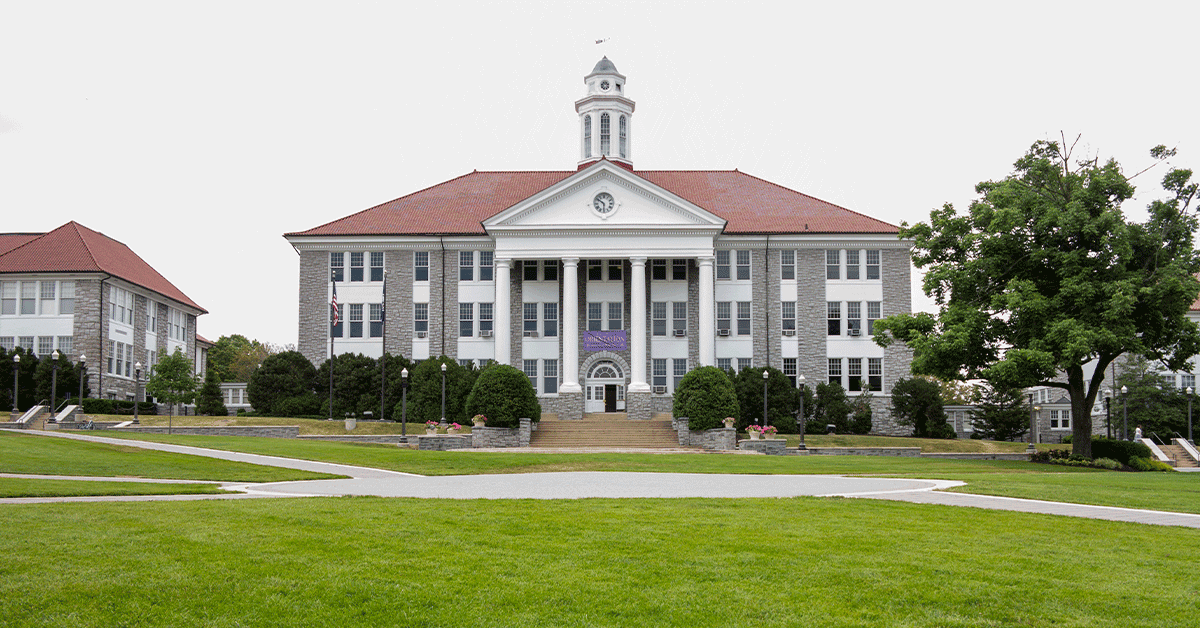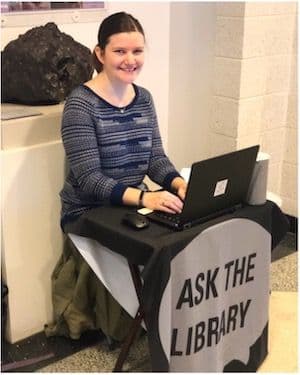Read an interview with Alyssa Young, the Science and Math Librarian at James Madison University.

Alyssa Young is the Science and Math Librarian at James Madison University.
Tell me about your current role:
I am the Science and Math Librarian at James Madison University (JMU), a primarily undergraduate institution in Harrisonburg, Virginia. I support the Biology, Chemistry and Biochemistry, Geology and Environmental Science, Mathematics and Statistics, and Physics and Astronomy departments.
Undergraduate research is a significant component of each department I work with, and I help faculty and students find, evaluate, and disseminate information through in-class instruction and one-on-one consultations. I also co-teach in a chemistry course that provides students with a deep dive into learning how to find and evaluate the chemical literature.

What is your background?
After volunteering at my public library while I was in high school and having a work-study in the library at college, I never thought I would become a librarian professionally. I graduated college with a BA in Sociology and a minor in African Studies. I initially planned to attend graduate school to become a social worker. After graduating, I served as a Team Leader in AmeriCorps NCCC, which let me travel across the United States and do service work.
When I came back home, I started back up at a job I held previous summers at a local homeless shelter, and I started applying to grad school. However, I paused my application process to save some more money. I then ended up working as a paraprofessional in a high school library, which inspired me to get my MLIS.
During the summers while I was pursuing my degree, I worked at a local farm that provided land to refugees and immigrants to grow their own crops to have for themselves or to sell at farmers’ markets. Between this farm and the fantastic science teachers at the high school I worked as a paraprofessional, I became interested in science librarianship. As a nonscientist in science librarianship, I am an asset in helping students and faculty with their skills of communicating science to a broader audience.
How do you help to address challenges faced by your institution’s students and faculty?
Since starting this role, I have shown students and faculty that I am available to help them with the various questions related to information they are searching for. I like to hold office hours weekly in the hallway of the science buildings to put myself in the location where many of the faculty and students work daily. While not all conversations are library consults, they have helped create relationships with faculty to help them know that I am here to help them. COVID-19 did change the practice of sitting in the hallways, but the relationships I made helped faculty know I could help them even if I was not physically there. They would instead find different ways for students to reach out to me when they needed help.
Many students have questions about how to find and effectively use the right resource to find various sources. This can help them learn how to expand their search terms, use a specific database, or use a citation management tool to organize the research they have been collecting.
Over the years, faculty have been asking more about the ever-changing publishing environment and how it might affect their research. This gets us into conversations on our monograph and e-book collections, databases, and how much the essential chemical information resources have changed over the years. I also help answer questions about incorporating information or data literacy into their teaching and searching for obscure citations they have found!
What are some trends that you are observing in the library world right now?
Changes to teaching, research, publishing, and administration all impact the library, as it is the epicenter of the university and has a significant role in supporting faculty and students. As a science librarian, this means knowing more about data services, scholarly communication, and open educational resources. These topics are becoming increasingly significant in the classroom and research lab.
There is also an emphasis on equity, diversity, inclusion, and social justice in teaching and research from libraries and the sciences. This is less of a trend and more of a practice we should always include in our work, for it is not something additional but part of our work. This can be as simple as having examples of research from chemists in marginalized communities, including stories of systemic issues within the sciences in our teaching, or purposefully including resources in our collections from and/or about marginalized communities.
What areas of interest are you focused on right now?
I am currently focused on creating lessons that help students understand the scientific publishing process. Many of the students I meet are partaking in undergraduate research and are interested in how research gets published, what scientists must do to get published, and how publications are shared with the scientific community. We have great conversations in these classes about open-access journals, preprints, and equity in the publication process.
What other associations are you currently active with?
I am currently active with Association of College and Research Libraries’ (ACRL) Science and Technology (STS) section. I joined during my first year as a librarian and have now served on two different committees. In addition, I am currently involved in the STS Equity, Diversity, and Inclusion Committee and volunteer as a mentor for the STS Mentoring Program.
A very important question: Who is your favorite scientist?
All the students and faculty I have had the pleasure of working with at JMU are my favorite scientists! The Chemistry and Biochemistry Department here get students involved in research during their first semester! The faculty are dedicated to their own research and enthusiastic about sharing their research with students and involving them throughout the process. The students are curious, budding scientists who are not afraid to ask questions and are excited to learn. They all continue to amaze me, and I am happy that I can help them in any way I can!
What is a fun fact about James Madison University?
One fun fact is that Science Hall (now Gabbin Hall) was one of only two buildings when JMU opened in 1909 as the State Normal and Industrial School for Women. The building served the academic and administrative needs of the entire school. It included classrooms and science laboratories, domestic economy, cooking, sewing, and drawing as well as the school’s first library!
Another fun fact is the chemistry department has a bulletin board in their building filled with chemistry memes. If someone needs a laugh, it is a great place to stop!

Read More Library Life Interviews
- Library Life: Interview with Northwestern University Librarian Elsa Alvaro
- Library Life: Interview with Carnegie Mellon University Librarian Neelam Bharti
- Library Life: Interview with University of Pennsylvania Librarian Judith Currano
- Library Life: Interview with Massachusetts Institute of Technology (MIT) Librarian Ye Li
- Library Life: Interview with University of Rochester Librarian Sue Cardinal
- Library Life: Interview with Caltech Librarian Dr. Donna Wrublewski